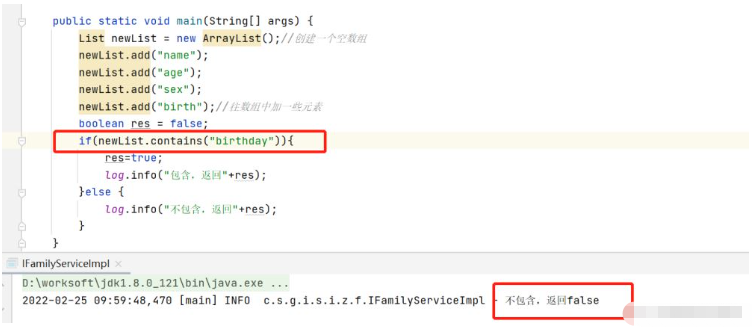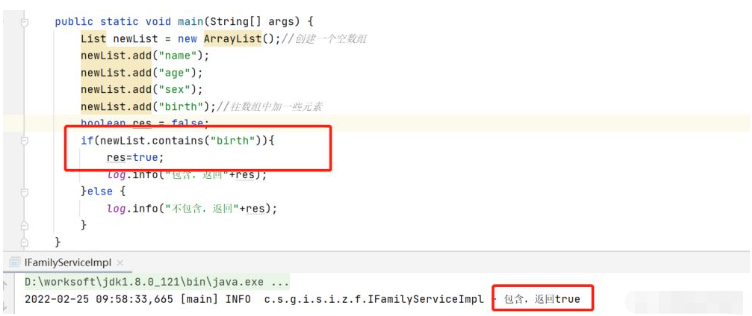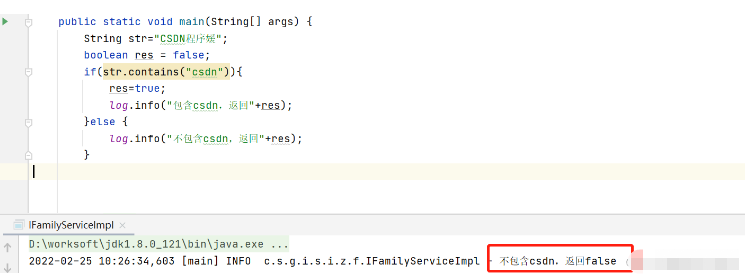How to use list.contains() in Java
1. Usage:
The contains() in the list collection is used to determine whether the collection contains the specified element . The list will compare the elements in the brackets with the elements existing in the list one by one. If there are equal elements, the return result is true, if not, the return result is false.
2. Example:
Use the following code to verify:
public static void main(String[] args) {
List newList = new ArrayList();//创建一个空数组
newList.add("name");
newList.add("age");
newList.add("sex");
newList.add("birth");//往数组中加一些元素
boolean res = false;
if(newList.contains("birthday")){
res=true;
log.info("包含,返回"+res);
}else {
log.info("不包含,返回"+res);
}
}Test whether the newList array contains the element "birthday"

Test whether the newList array contains the element "birth"

3. Expand the contains() method in
String class: if and only When this string contains the specified char value sequence, it is judged whether the specified content contains the content in brackets.
Example:
public static void main(String[] args) {
String str="CSDN程序媛";
boolean res = false;
if(str.contains("程序媛")){
res=true;
log.info("包含程序媛,返回"+res);
}else {
log.info("不包含程序媛,返回"+res);
}Test whether the String type "CSDN Program Yuan" contains "Program Yuan"

If the String type string contains When using letters, you need to pay attention to case sensitivity
Test whether the String type "CSDN Program Yuan" contains lowercase "csdn"

Supplement: The List.contains() method in Java compares the address rather than the value
Use the List.contains(Object object) method to determine whether the ArrayList contains an element object (For the case where the object's attribute values are the same but the object addresses are different), if the equals method in the element object Object of List
Use List.contains(Object object ) method to determine whether the ArrayList contains an element object (for the case where the object's attribute value is the same but the object address is different). If the equals method in the element object Object of List
@Override
public boolean equals(Object o) {
// TODO Auto-generated method stub
return super.equals(o);
}will cause the contains method to always return false.
View the source code of the contains method of ArrayList as follows:
/**
* Searches this {@code ArrayList} for the specified object.
*
* @param object
* the object to search for.
* @return {@code true} if {@code object} is an element of this
* {@code ArrayList}, {@code false} otherwise
*/
@Override public boolean contains(Object object) {
Object[] a = array;
int s = size;
if (object != null) {
for (int i = 0; i < s; i++) {
if (object.equals(a[i])) {
return true;
}
}
} else {
for (int i = 0; i < s; i++) {
if (a[i] == null) {
return true;
}
}
}
return false;
}It can be seen that the contains method determines whether a certain element is included based on the equals method of Object. Continue to check the equals method in the Object class. The source code is as follows:
public boolean equals(Object o) {
return this == o;
}So, use "==" to compare the addresses of objects. If it is the same object, that is, the address is the same, true will be returned. For different objects with the same object attribute value but different addresses , always returns false!
If you need to determine whether the ArrayList contains an object based on whether the object attribute values are the same, you need to override the equals method of Object and compare each attribute value of the object one by one in the equals method, such as:
package com.feng.lejuan.entity;
public class QuestionInfo {
private String questionId;
private String answerId;
private String subQuestionId;
private String result;
public QuestionInfo() {
super();
}
public QuestionInfo(String questionId, String answerId,
String subQuestionId, String result) {
super();
this.questionId = questionId;
this.answerId = answerId;
this.subQuestionId = subQuestionId;
this.result = result;
}
public String getQuestionId() {
return questionId;
}
public void setQuestionId(String questionId) {
this.questionId = questionId;
}
public String getAnswerId() {
return answerId;
}
public void setAnswerId(String answerId) {
this.answerId = answerId;
}
public String getSubQuestionId() {
return subQuestionId;
}
public void setSubQuestionId(String subQuestionId) {
this.subQuestionId = subQuestionId;
}
public String getResult() {
return result;
}
public void setResult(String result) {
this.result = result;
}
@Override
public boolean equals(Object o) {
if (o instanceof QuestionInfo) {
QuestionInfo question = (QuestionInfo) o;
return this.questionId.equals(question.questionId)
&& this.subQuestionId.equals(question.subQuestionId)
&& this.answerId.equals(question.answerId)
&& this.result.equals(question.result);
}
return super.equals(o);
}
@Override
public String toString() {
return "QuestionInfo [questionId=" + questionId + ", answerId="
+ answerId + ", subQuestionId=" + subQuestionId + ", result="
+ result + "]";
}
}The above is the detailed content of How to use list.contains() in Java. For more information, please follow other related articles on the PHP Chinese website!

Hot AI Tools

Undresser.AI Undress
AI-powered app for creating realistic nude photos

AI Clothes Remover
Online AI tool for removing clothes from photos.

Undress AI Tool
Undress images for free

Clothoff.io
AI clothes remover

AI Hentai Generator
Generate AI Hentai for free.

Hot Article

Hot Tools

Notepad++7.3.1
Easy-to-use and free code editor

SublimeText3 Chinese version
Chinese version, very easy to use

Zend Studio 13.0.1
Powerful PHP integrated development environment

Dreamweaver CS6
Visual web development tools

SublimeText3 Mac version
God-level code editing software (SublimeText3)

Hot Topics
 1378
1378
 52
52
 Perfect Number in Java
Aug 30, 2024 pm 04:28 PM
Perfect Number in Java
Aug 30, 2024 pm 04:28 PM
Guide to Perfect Number in Java. Here we discuss the Definition, How to check Perfect number in Java?, examples with code implementation.
 Random Number Generator in Java
Aug 30, 2024 pm 04:27 PM
Random Number Generator in Java
Aug 30, 2024 pm 04:27 PM
Guide to Random Number Generator in Java. Here we discuss Functions in Java with examples and two different Generators with ther examples.
 Weka in Java
Aug 30, 2024 pm 04:28 PM
Weka in Java
Aug 30, 2024 pm 04:28 PM
Guide to Weka in Java. Here we discuss the Introduction, how to use weka java, the type of platform, and advantages with examples.
 Smith Number in Java
Aug 30, 2024 pm 04:28 PM
Smith Number in Java
Aug 30, 2024 pm 04:28 PM
Guide to Smith Number in Java. Here we discuss the Definition, How to check smith number in Java? example with code implementation.
 Java Spring Interview Questions
Aug 30, 2024 pm 04:29 PM
Java Spring Interview Questions
Aug 30, 2024 pm 04:29 PM
In this article, we have kept the most asked Java Spring Interview Questions with their detailed answers. So that you can crack the interview.
 Break or return from Java 8 stream forEach?
Feb 07, 2025 pm 12:09 PM
Break or return from Java 8 stream forEach?
Feb 07, 2025 pm 12:09 PM
Java 8 introduces the Stream API, providing a powerful and expressive way to process data collections. However, a common question when using Stream is: How to break or return from a forEach operation? Traditional loops allow for early interruption or return, but Stream's forEach method does not directly support this method. This article will explain the reasons and explore alternative methods for implementing premature termination in Stream processing systems. Further reading: Java Stream API improvements Understand Stream forEach The forEach method is a terminal operation that performs one operation on each element in the Stream. Its design intention is
 TimeStamp to Date in Java
Aug 30, 2024 pm 04:28 PM
TimeStamp to Date in Java
Aug 30, 2024 pm 04:28 PM
Guide to TimeStamp to Date in Java. Here we also discuss the introduction and how to convert timestamp to date in java along with examples.
 Java Program to Find the Volume of Capsule
Feb 07, 2025 am 11:37 AM
Java Program to Find the Volume of Capsule
Feb 07, 2025 am 11:37 AM
Capsules are three-dimensional geometric figures, composed of a cylinder and a hemisphere at both ends. The volume of the capsule can be calculated by adding the volume of the cylinder and the volume of the hemisphere at both ends. This tutorial will discuss how to calculate the volume of a given capsule in Java using different methods. Capsule volume formula The formula for capsule volume is as follows: Capsule volume = Cylindrical volume Volume Two hemisphere volume in, r: The radius of the hemisphere. h: The height of the cylinder (excluding the hemisphere). Example 1 enter Radius = 5 units Height = 10 units Output Volume = 1570.8 cubic units explain Calculate volume using formula: Volume = π × r2 × h (4




